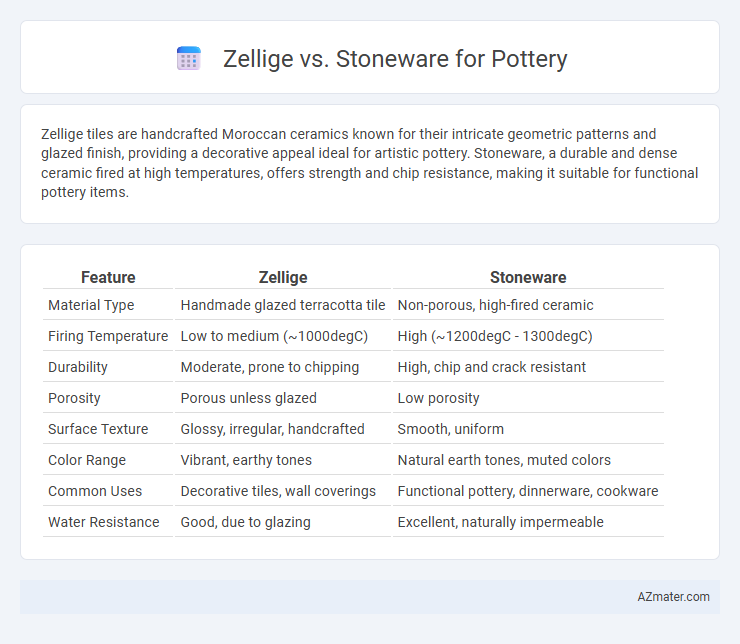Zellige tiles are handcrafted Moroccan ceramics known for their intricate geometric patterns and glazed finish, providing a decorative appeal ideal for artistic pottery. Stoneware, a durable and dense ceramic fired at high temperatures, offers strength and chip resistance, making it suitable for functional pottery items.
Table of Comparison
| Feature | Zellige | Stoneware |
|---|---|---|
| Material Type | Handmade glazed terracotta tile | Non-porous, high-fired ceramic |
| Firing Temperature | Low to medium (~1000degC) | High (~1200degC - 1300degC) |
| Durability | Moderate, prone to chipping | High, chip and crack resistant |
| Porosity | Porous unless glazed | Low porosity |
| Surface Texture | Glossy, irregular, handcrafted | Smooth, uniform |
| Color Range | Vibrant, earthy tones | Natural earth tones, muted colors |
| Common Uses | Decorative tiles, wall coverings | Functional pottery, dinnerware, cookware |
| Water Resistance | Good, due to glazing | Excellent, naturally impermeable |
Introduction to Zellige and Stoneware
Zellige tiles are traditional Moroccan ceramics characterized by intricate geometric patterns and a glossy, glazed finish that reflects artisanal craftsmanship, typically made from natural clay fired at lower temperatures. Stoneware, in contrast, is a durable pottery type fired at high temperatures, resulting in a dense, non-porous material ideal for both functional wares and decorative elements. While Zellige emphasizes ornamental designs and cultural heritage, stoneware offers strength and versatility for everyday use.
Historical Background of Zellige and Stoneware
Zellige, a traditional Moroccan art form dating back to the 10th century, is characterized by intricate geometric patterns crafted from hand-cut glazed terracotta tiles, reflecting Islamic architectural influence. Stoneware, originating around 10,000 BCE with early Chinese pottery, is a durable, non-porous ceramic fired at high temperatures, widely used in both utilitarian and artistic contexts across various cultures. Both Zellige and stoneware showcase distinct historical craftsmanship, with Zellige emphasizing decorative mosaic tilework and stoneware emphasizing robust, functional ceramics.
Material Composition: Zellige vs Stoneware
Zellige tiles are crafted from natural clay and feature a high concentration of silica and iron oxide, which gives them their distinctive terracotta base and vibrant glazes. Stoneware, composed primarily of refined clay and feldspar, undergoes a higher firing temperature resulting in a dense, non-porous material with superior durability. The key difference lies in Zellige's hand-molded, porous ceramic structure versus stoneware's vitrified, dense composition that enhances water resistance and strength.
Aesthetic Qualities and Visual Appeal
Zellige tiles showcase intricate geometric patterns and vibrant, glossy glazes that create a striking visual impact, emphasizing traditional Moroccan artistry. Stoneware pottery offers a more muted, natural palette with matte finishes and organic textures, highlighting rustic and earthy aesthetics. The choice between Zellige and stoneware influences the overall ambiance, with Zellige adding bold decorative flair and stoneware contributing subtle, tactile sophistication.
Durability and Longevity Comparison
Zellige tiles, crafted from natural clay and traditionally hand-glazed, offer moderate durability with a unique aesthetic but are more susceptible to chipping and wear compared to stoneware. Stoneware pottery, fired at higher temperatures around 1200-1300degC, provides superior strength, water resistance, and longevity, making it ideal for heavy-use applications. The dense and vitrified composition of stoneware ensures greater durability and longer lifespan than the porous, softer surface of zellige, which requires more careful maintenance to preserve its appearance over time.
Craftsmanship and Manufacturing Processes
Zellige pottery involves intricate hand-cut ceramic tiles originating from Moroccan craftsmanship, requiring meticulous artisanship in shaping and assembling glazed pieces to create geometric patterns. Stoneware pottery, typically fired at higher temperatures, emphasizes durability and functional design through refined clay processing and kiln techniques that produce dense, non-porous ceramics. Both methods showcase distinct manufacturing processes where Zellige prioritizes decorative tile mosaic craftsmanship, while stoneware focuses on strength and utility through advanced firing technology.
Functional Applications in Pottery
Zellige tiles, made from glazed terracotta, offer excellent water resistance and intricate surface textures, making them ideal for decorative pottery and functional items requiring visual appeal combined with durability. Stoneware, fired at higher temperatures, provides superior strength, chip resistance, and porosity, making it the preferred material for utilitarian pottery such as dinnerware, cookware, and storage containers. Both materials excel in functional applications by balancing aesthetic qualities and practical performance, with stoneware favored for heavy-duty use and zellige valued in ornamental or light-use pottery.
Cost and Accessibility Factors
Zellige tiles, known for their intricate handcrafted designs, tend to be more expensive due to labor-intensive production and limited regional availability, primarily sourced from Morocco. Stoneware pottery offers a more cost-effective alternative, benefiting from widespread manufacturing and greater accessibility through numerous global suppliers. The price disparity largely stems from the artisanal nature of Zellige compared to the mass-produced characteristics of stoneware, influencing choice based on budget and availability.
Maintenance and Care Differences
Zellige tiles require gentle cleaning with mild soap and water to preserve their hand-glazed, porous surface, avoiding abrasive materials that can damage the intricate patterns. Stoneware pottery is more durable and resistant to stains, allowing for easier maintenance through regular scrubbing with non-abrasive sponges and dishwasher-safe care. Both materials benefit from sealing treatments to enhance longevity, but Zellige demands more cautious handling to prevent chipping or color fading over time.
Which to Choose: Zellige or Stoneware for Your Pottery Project
Zellige tiles offer intricate geometric patterns and rich color variations, ideal for decorative pottery projects seeking an artisanal, Moroccan-inspired aesthetic. Stoneware provides durability and versatility with its dense, non-porous clay body, suitable for functional pottery requiring strength and water resistance. Choose Zellige for ornamental, textured surfaces, while stoneware is preferable for practical, everyday use pieces that demand robustness.

Infographic: Zellige vs Stoneware for Pottery
 azmater.com
azmater.com